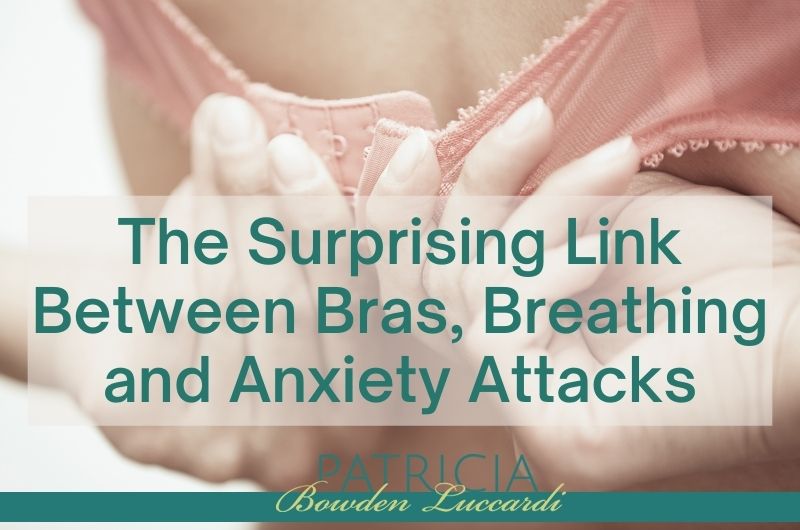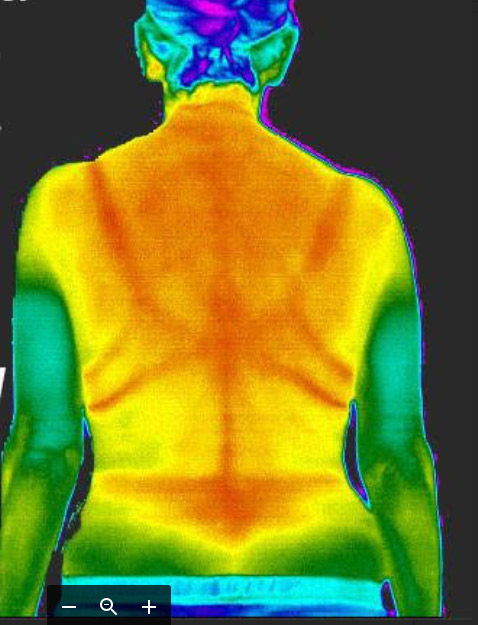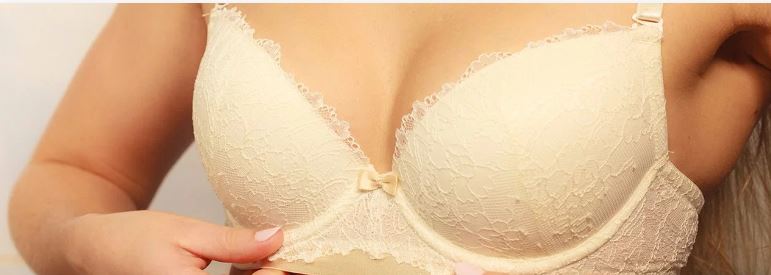The Surprising Link Between Bras, Anxiety and Panic Attacks
Leave a Comment
Stress in this time of rapid change is a number one health concern and for good reason. In fact, the US Public Health Service has made stress reduction its number one health-promoting goal.
No one is immune to having experienced some form of stress and anxiety. Women may be even more prone due to wearing tight bras that could be undermining their capacity to breathe correctly.
If you are like me, when I get home, the first thing I take off after my shoes is my bra! I’ve been known to take my bra off even while driving.
Let’s explore the relationship between bras, stress and anxiety, and breathing.
Tight Bras and Women’s Health
As a thermographer, I see first hand the marks that tight bras leave on a woman’s rib cage, which can set the stage for chest or shallow breathing.
The tighter the constriction on the rib cage, the greater the possibility of the breath rising high into the chest.
Chest breathing calls on the sympathetic nervous system, the flight and flight breath or the breath that can create anxiety and even panic attacks.

Thermographic scan of woman who has not been wearing a bra for 15 minutes. Lymphatic backup.
Correct breathing, or diaphragmatic breathing, is a parasympathetic nervous system breath. Also called the ‘rest and digest breath,’ or the calming breath, this type of breathing is difficult in tight bras.
Bras, it seems, over the years have become more constrictive, with push up pads, underwires, Spanx, super tight sports bras, and all kinds of crazy shapes and sizing. Some of these restrictive options aren’t too far-removed the archaic Victoria corset.
Sadly, during the era of the corset, many women were dying of ‘consumption,’ another term for tuberculosis during Victorian times. By wearing a corset, the breath could not reach the bottom of the lungs, where oxygen reaches the alveoli and is exchanged into the blood. Corsets were not the cause, but they contributed to the rise in lung disease.
In response, ‘health corsets’ became popular, made with elastic fabric that were introduced as a way to alleviate pressure on the ribs caused by the heavily boned corsets of the Victorian era.
Women at this time were also prone to fainting because they could not breathe. They even created fainting rooms for women. This was also a time when some women were considered ‘hysterical’ and ‘nervous ninnies.’ Doctors told women they needed to have orgasms to calm down. Imagine that!
This fascinating article from the Smithsonian explores the impact of fashion and corsets on women’s health. It’s a real head-shaker of stupidity.
But some of the bras on the market today have similar issues, creating breathlessness that leads to anxiety and stress. If you love your bras and they are tight, buy a bra extender. They come in multiple sizes of hooks and colors. Or consider wearing bralettes, which are less constrictive.
Bras and Your Breath

Many people use shallow or chest breath patterns that are undermining their physical, mental and emotional health. Bras can exacerbate this constriction, contributing to greater chest breathing and over-breathing.
The rib cage is triangle-shaped, with the diaphragm tucked under at the widest bottom of the rib cage. When breathing properly, the bottom of the ribcage expands and the diaphragm descends, billowing out the belly.
Tight clothing like bras that constrict the rib cage will force the breath high into the chest, hence the term chest breathing.
Chest breathers are often associated with Type A personalities. How do you know if you are a chest breather? Sit up straight. Place your left hand on your chest and right hand on your abdomen. Take a few deep breaths. Which hand moves first? If it is the left hand, you are a chest breather.
When you breathe with your chest, you are using your secondary breathing muscles instead of primary muscles. Efficient breathing uses the diaphragm, but in chest breathing we are using the intercostals and abdominal muscles.
Moreover, chest breathing depends on weak upper chest and neck muscles, such as the trapezius, scalenes and pectorals. Therefore, chronic chest breathing can lead to chronic tension in the upper thoracic, shoulders and neck. The abdominals are usually chronically tight and all the organs of the body suffer from poor circulation.
There is strong scientific evidence linking chest breathing to high blood pressure and heart disease. The most alarming thing that happens during chest breathing is that the diaphragm is prevented from descending completely, which has an immediate impact on the blood flow back into the heart. Tight jeans can also exacerbate this.
Are You Over-Breathing?
Panic attacks are becoming more common. This could be the times we are in, or maybe it’s due to ribcage constriction or stress and anxiety causing over-breathing.
Over-breathing, or ‘hidden hyperventilation,’ happens when you experience 16 or more breaths per minute. It can mimic serious health concerns that can result in misdiagnosis and over-medicating, which are attributed to sixty percent of urban ambulance calls!
Couple overbreathing with wearing a mask all day and you have a potent brew for anxiety and even panic attacks.
Chronic or Hidden Hyperventilation is usually not recognized except in it’s extreme forms, although it can be both chronic and subtle. In fact, it is chronic low grade overbreathing that may be one of the most under-diagnosed health problems of our time.
When you are sitting quietly you breathe 13-15 breaths per min. Women usually breathe 12-14 breaths. But when we develop the habit of hyperventilating we breathe fast no matter what we are doing. This type of breathing has the patterns of chest breathing.
When the diaphragm is not used to its full extent this results in limited lung capacity and less oxygen being taken in. Most people will compensate by breathing in more breaths, thus causing over-breathing.
The first thing that happens with over-breathing is one loses too much carbon dioxide. Carbon dioxide is the crucial ingredient in helping maintain the right acid-alkaline balance in the blood. The slightest alterations in the pH of the body can make marked alterations in the rates of chemical reactions in the cells, slowing some down and speeding others up. When the body loses too much carbon dioxide the metabolism shifts from acid to alkaline.
Muscular tension and pain can manifest in cramps, tight occipitals, neck, shoulders, pain between the scapula, twitching and stiffness. As far back as 1978 the Journal of American Medical Association produced a list of symptoms thought to be associated with chronic or hidden hyperventilation. They include but are not limited to fatigue, exhaustion, heart palpitations, rapid pulse, numbness and tingling in the limbs, shortness of breath, yawning, stomach pains, cramps, difficulty swallowing, dry throat and mouth, belching, flatulence, abdominal bloating, acid reflux, heart burn, stiffness, anxiety, nightmares, insomnia, sweaty palms, impairment of concentration and memory and a feeling of losing one’s mind!
Focus On Your Breath
That’s why we need to wear less restrictive clothing, and bring our focus back to our breath. Breath is one of the greatest gifts we have been given, but often it goes unopened.
Breath is the simplest most effective stress-reducing tool in your survival kit, providing you are breathing correctly. By engaging with the breath, we increase our lifespan, relax chronic muscle tension, regain a clear mind and increase immune function – thus increasing our vitality. Yet, by ignoring the breath, we can lay the foundation for ill health.
Be mindful of your ribcage constriction, tight pants, poor posture and the depth and quality of your breath. Loosen your bra. And practice deep, mindful breathing, like I outline below. It is one of the fastest ways to come home to yourself and have peace of mind.
Long Complete Deep Breath
Sit straight. If the spine is in a balanced position, the ribs and muscles are able to move freely.
Begin to breathe into the abdomen, then into the chest and finish with the clavicle. All three are done in a smooth motion. As you exhale, start by relaxing the clavicle then slowly emptying the chest. Finally pull in the abdomen and force out any remaining air.
What this exercise will do for you:
- Relax and calm you
- Give you clarity, cool headedness and patience
- Reduce and prevent build up of toxins in the lungs
- Stimulate the chemicals in the brain to fight depression
- Build the aura in strength
- Lung capacity is expanded
Yours in radiant health and deep breathing,
Patricia
